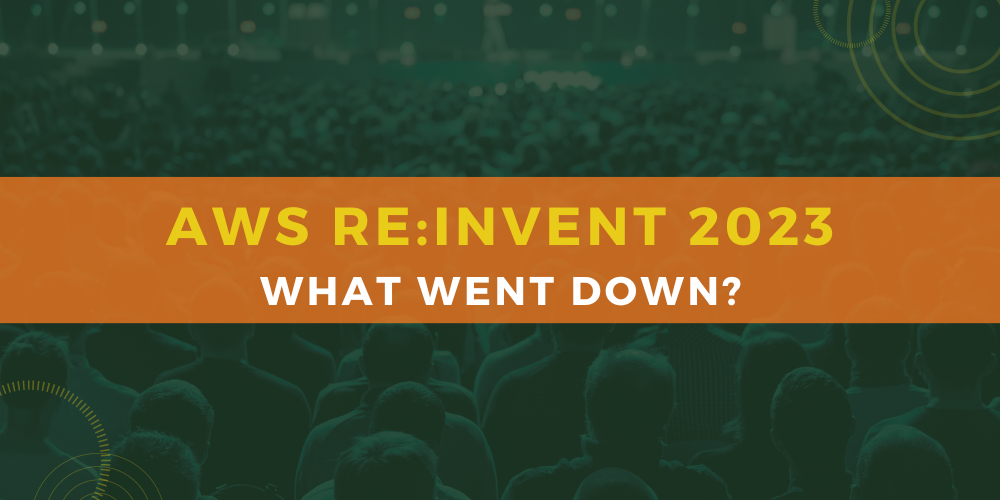
As the desert dust settles on AWS Re:Invent 2023, we’re recapping the hottest announcements and most important takeaways from the biggest cloud event of the year.
Hosted once again among the bright lights of fabulous Las Vegas, Nevada, the annual five-day conference from AWS featured a wide range of exciting speeches, training workshops, demonstrations and labs, including an unmissable keynote speech from AWS CEO, Adam Selipsky, that you can check out below.
So what went down at AWS Re:Invent 2023? We’ve rounded up all the biggest talking points, insights, and announcements from across the conference so that professionals and organizations from across the community can stay well-informed on all the latest and greatest from the world of AWS.
Amazon Q stole the show
It’s probably no surprise to learn that AI was the star of the show, with artificial intelligence firmly establishing itself in the mainstream this year through the emergence of accessible and effective generative AI solutions. Unless you’ve been living under a rock—no, in fact, even if you’ve been living under a rock—you’ve no doubt heard of ChatGPT, for example.
At Re:Invent 2023, AWS announced a new generative AI tool assistant specifically for work, named Amazon Q. But don’t be fooled into thinking that this is just any old AI chatbot. Built with security and privacy in mind, Amazon Q can be tailored specifically to your business and goes beyond simple interactions to unlock the full transformational potential of AI for employees everywhere.
No matter the size of your organization or your industry vertical, Amazon Q is capable of generating content and leveraging AWS knowledge to provide tailored solutions for a near-endless amount of use cases. Whether you’re looking to streamline tasks, accelerate decision-making, or help spark creativity and innovation at work, employees can ask Amazon Q questions via a seamless conversational interface and receive custom outputs based on Amazon Q’s understanding of your company’s unique information repositories, code bases, and enterprise systems.
Unlike Frank Ocean at Coachella, this year’s headline act sure didn’t disappoint, with Amazon Q looking set to be a revolutionary tool that empowers organizations to overcome barriers sooner, find more effective solutions, and achieve more than what was thought possible. And it starts today; as Adam Selipsky revealed in his keynote, a new collaboration between AWS and Accenture will help developers and enterprise customers accelerate the adoption of Amazon Q.
The next generation of AWS chips was unveiled
We’re sure you agree that this rapid evolution of generative AI is mighty impressive, but what’s powering this amazing advancement? After all, the foundation models underpinning these tools are trained on massive—and we mean massive—datasets. And if that wasn’t enough, customers are still seeking the ability to train these models faster and at lower cost, all while reducing the amount of energy they use.
Enter AWS Graviton4 and AWS Trainium2.
AWS Graviton4 and AWS Trainium2 are the next generation of AWS-designed chips, marking a significant advancement in AI model training and inferencing. In fact, AWS Graviton4 is the most powerful and energy-efficient AWS processor to date, suitable for a wide range of cloud workloads. And the data speaks for itself: Graviton4 provides up to 30% better compute performance, 50% more cores, and 75% more memory bandwidth than current generation Graviton3 processors.
All the while, AWS Trainium2 will power the highest performance compute on AWS for training foundation models faster and at lower cost and energy, designed to deliver up to 4x faster training than first-generation Trainium chips and able to be deployed in EC2 UltraClusters of up to 100,000 chips.
This announcement signals a huge breakthrough in the implementation of AI across the professional landscape, with these chips helping to overcome significant adoption barriers by making AI faster, less expensive, and more energy efficient than ever before.
Amazon Bedrock received powerful new updates
You didn’t think we were done talking about AI, did you? We told you it was the star of 2023!
The general availability of Amazon Bedrock was announced back in October, offering users five generative AI innovations to help organizations of all sizes develop new applications, enhance employee productivity, and transform their businesses.
At Re:Invent 2023, Adam Selipsky unveiled a range of exciting new capabilities added to Amazon Bedrock. These updates include:
- Knowledge Bases: it’s now even easier to build generative AI applications like chatbots and question-answering systems that use proprietary data to deliver custom responses
- Agents: generative AI applications can now execute multistep business tasks using company systems and data sources
- Guardrails: organizations can now implement custom safeguards like language boundaries and data protection enhancements to maintain compliance and adhere to guidelines when building AI applications
- Fine-tuning: fine-tuning support for Cohere Command Lite, Meta Llama 2, and Amazon Titan Text models mean that users have more customization offers than ever
- More models: users now have a wider choice of industry-leading models when building and scaling generative AI applications including Anthropic, Cohere, Meta, Stability AI, and new models in the Amazon Titan family
New capabilities were revealed for SageMaker
OK, OK, one last mention of AI.
Amazon SageMaker offers users a full-managed service with a selection of tools that enable highly effective and cost efficient machine learning for all sorts of us cases.
At Re:Invent, AWS Vice President of Data and AI Swami Sivasubramanian, unveiled new capabilities for the service, meaning it’s now even easier to build, train, and deploy models for generative AI. New features customers can now explore include:
- SageMaker Inference: users can now deploy multiple models to the same AWS instance to reduce deployment costs and minimize latency
- SageMaker HyperPod: training time has been accelerated by 40% for improved model performance. Users can automatically split training workloads across thousands of accelerators, meaning workloads are now able to be processed in parallel
- SageMaker Canvas updates: users can integrate generative AI into the workflows quicker and easier than ever with two new launches in Canvas
- SageMaker Clarify: to support responsible use of AI, users are assisted in evaluating, comparing, and identifying the best model for their use case based on the parameters they determine
Enough about AI! Moving on to another hot topic of Re:Invent 2023, let’s talk about data and storage…
Amazon Neptune Analytics was made generally available
In his keynote, Swami Sivasubramanian also announced Amazon Neptune Analytics, combining the power of both graph and vector databases to enable users to analyze graph data or data lakes stored in Amazon S3.
“Since both graph analytics and vectors are all about uncovering the hidden relationships across our data, we thought to ourselves: what if we combined vector search with the ability to analyze massive amounts of graph data in just seconds,” he explained.
AWS’ answer to the graph vs vector database debate is quite simple: both. And this robust integration promises a wave of new opportunities for customers to conduct comprehensive analysis of complex datasets. For example, with the general availability of Amazon Neptune Analytics, users can identify patterns and trends from complex relationships by analyzing graph data or data lakes on top of S3 storage, and using vector search to uncover key insights.
The announcement of this new analytics database engine means that data scientists and developers can accurately analyze a large amount of graph data faster than ever before, with AWS, in their own words; ‘taking care of the infrastructure heavy lifting, enabling you to concentrate on problem-solving through queries and workflows.’
Find out more about Amazon Neptune Analytics
New serverless innovations were introduced
New serverless offerings from AWS are intended to help customers simplify the way they analyze and manage data at any scale, helping more organizations make the most out of their data.
At the Re:Invent conference, Senior Vice President of AWS Utility Computing, Peter DeSantis, unveiled three new AWS serverless innovations to empower users to do more with data sets big and small. The announcement means organizations can unlock a wave of exciting new capabilities, like being able to scale capacity to meet even the most demanding applications at a moment’s notice.
To build on the work AWS has been doing since they first launched Amazon S3: Amazon Simple Storage Service, Peter DeSantis announced innovations for:
Amazon S3 Express One Zone was announced
AWS is billing its latest S3 announcement as ‘the speediest Amazon S3 storage class ever’ – and the numbers don’t lie. Amazon S3 Express One Zone, released at Re:Invent 2023, is designed to provide data access speeds up to 10 times faster, with request costs up to 50% lower than Amazon S3 standard.
Amazon S3 holds more than 350 trillion pieces of data (known as ‘objects’), and averages more than 100 million requests for data per second—yep you read that right; per second.
With Express One Zone, you can select a specific AWS Availability Zone within an AWS Region to store your data, meaning users can access a new purpose-built storage class for running applications that require extremely fast data access, to guarantee the utmost efficiency every time.
Find out more about Amazon S3 Express One Zone
Other cool announcements from Re:Invent 2023 that we think you should know about:
- Amazon One Enterprise: this new service uses innovative palm recognition technology to offer customers a contactless and convenient way to authorize personnel in seconds, and grant access to areas like offices, hotels and resorts, and private institutions
- AWS Clean Rooms Differential Privacy: marking a big step forward in user privacy, this new feature, currently in preview, aims to improve the protection of user data by creating a more secure experience with mathematically-backed and intuitive controls
- AWS Supply Chain updates: AWS announced four new updates to AWS Supply Chain following its launch at last year’s event. New capabilities built around supply planning, collaboration, sustainability, and Amazon Q will help users to reduce inventory costs, respond more quickly to demand, and streamline communication with suppliers
- Amazon OpenSearch Service: the unveiling of highly durable Amazon OpenSearch Service clusters promise a 30% improvement in price/performance, offering a more comprehensive and cost-effective solution for those leveraging OpenSearch Service
Don’t just rely on us to give you the lowdown on the next unmissable AWS event! Mark all the important dates in your diary by checking out our AWS 2024 Event Calendar—we’re updating it as and when new conferences, summits, and community days are announced throughout the year!



